|
|
January 28th, 2011
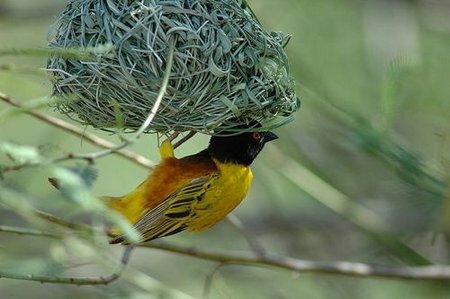
It can be hard to get noticed when you’re a little chick in a big colony, but new research published in BioMed Central’s open access journal BMC Ecology reveals that baby birds in need of a feed have individual ways of letting their parents know. [Science Daily]
January 26th, 2011
Mike Buckham joined me on Saturday (22-01-11) for another raptor watch at Kirstenbosch. The conditions weren’t great with a strong black south-easter (lots of cloud cover over the mountain), but Kirstenbosch was thankfully quite sheltered. We didn’t expect a great raptor tally, particularly because we had 4 children in tow who found stone throwing far more entertaining than discussing the nuances of Forest vs. Steppe Buzzard separation. We did however put them to work with an incentive scheme that offered a wine gum for each raptor spotted. Young eyes are surprisingly sharp, particularly when energised with a bit of sugar…
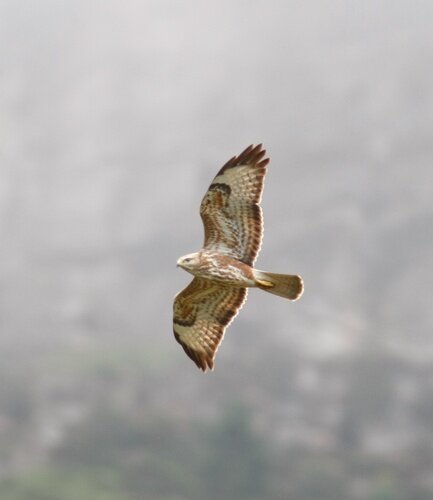
Forest Buzzard
So, despite wind and hyper-active kids we did actually see some raptors. The cloud conditions can actually help photography slightly, particularly for shots against the mountain – see buzzard image above. However, I believe windless, warm days are generally better for encouraging soaring activity.
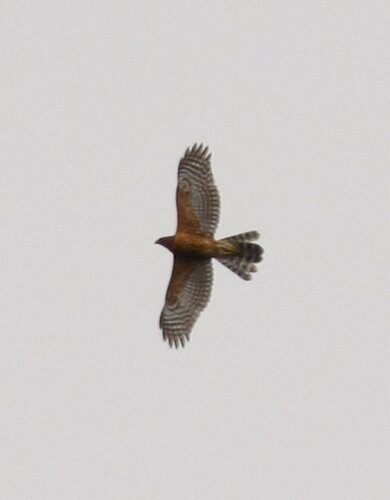
Black Sparrowhawk
In total we notched up 6 raptors before the wind got the better of us: Booted Eagle (pale phase), Steppe Buzzard, Forest Buzzard, Yellow-billed Kite (2 birds did a very close fly-by), Rock Kestrel and finally an immature Black Sparrowhawk (photo above).
David Winter
January 21st, 2011
A short raptor watch at Kirstenbosch Botanical Gardens on Saturday 15 January 2011 really turned up the goods. I always feel slightly deprived when a summer passes and I haven’t seen at least one Honey Buzzard on the Cape Peninsula. Last year was one of those where, despite putting in some time at Kirstenbosch and Newlands Forest, no Honeys were recorded.
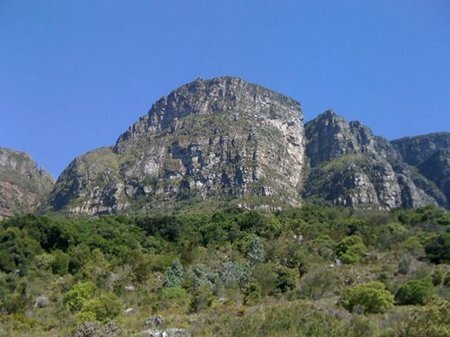
I’m pleased to report a different state of affairs this year. No sooner than 5 minutes after arriving at Kirstenbosch on Saturday (10:15am) an immature Honey Buzzard caught my attention. I was far from prepared for this early kick-off and only managed to rattle off a couple of shots before my camera’s card was full. Nevertheless, I managed to capture this image, which shows the diagnostic features.
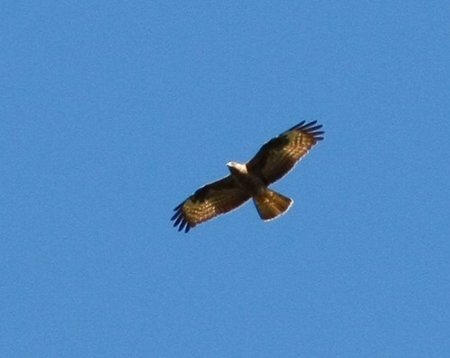
Honey Buzzard (immature)
I’m amazed how frequently I see African Harrier Hawk in the Southern Suburbs these days. I can still recall painstakingly trying to track my lifer down in the Warmbaths area back in the early 90′s as it was particularly uncommon in the Western Cape at that time. On Saturday I was entertained by two adult birds completing an extensive aerial display that lasted at least 30 minutes. One of the birds would complete a series of consecutive dives and sharp vertical rises, shaking its wings just at the top of each rise, while the other circled below.
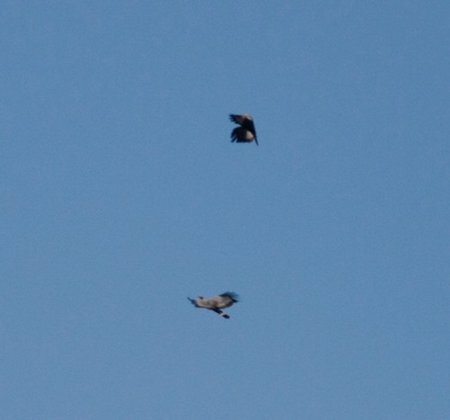
African Harrier Hawks displaying
Roberts reports the following regarding such displays:
In breeding display, 1 (sometimes both) of pair sours high in air, in slow and buoyant flight, usually silent. Sometimes makes shallow undulations with exaggerated wing fluttering. Sometimes male stalls, falls backwards and drops into a dive; may dive on soaring female, who turns onto her back and extends legs so that they briefly tough claws. Such flights average 20 minutes (11 – 33 minutes, n = 10).
In-between soaring Honeys and displaying Harrier Hawks there were a smattering of Steppe Buzzards (probably 5 individual birds in total), a lone Rock Kestrel, a distant Booted Eagle, an immature African Fish Eagle (below) and at least one vocal Forest Buzzard. I was chuffed with the Fish Eagle, it’s only the second time I’ve seen this species at Kirstenbosch and interestingly the last time it was also an immature.
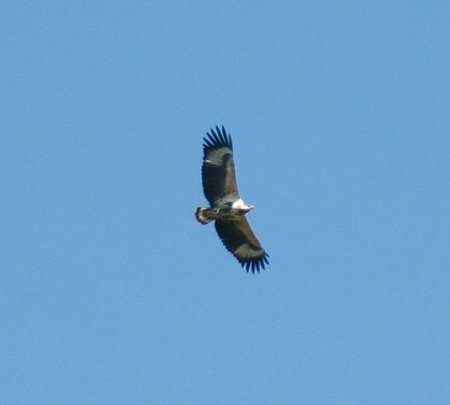
African Fish Eagle (immature)
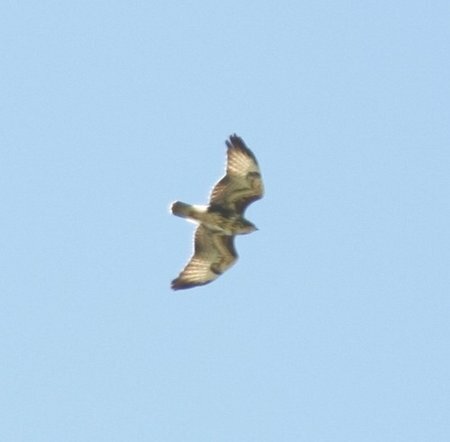
Forest Buzzard
Thinking the morning couldn’t get any better, whilst photographing a passing buzzard my attention was drawn to a soaring falcon, which struck me by its long-tailed and winged appearance and its dissimilarity with expected falco species. The bird was fairly distant, but I managed to snap a few record shots, which I circulated for comment here earlier this week. Below are two of the images.
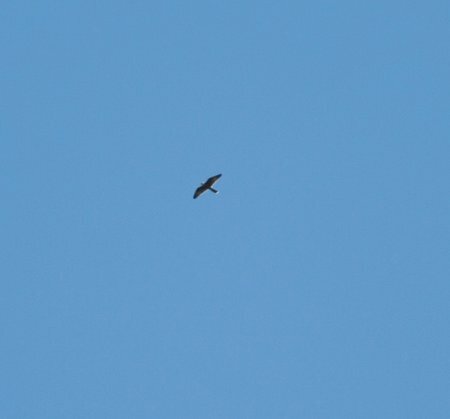

My suspicions at the time, and now following input from a variety of raptor experts, is that the bird may have been an Eleonora’s Falcon. Other suggestions from people have included Lanner, Peregrine and European Hobby. Out of interest, John Graham recorded an Eleonora’s Falcon at Kirstenbosch back in 2006 and managed to grab a few shots of the soaring bird. Subsequent to his sighting he created this series of photos, which includes his Kirstenbosch bird on the left and then an Eleonora’s image from the web for comparison.
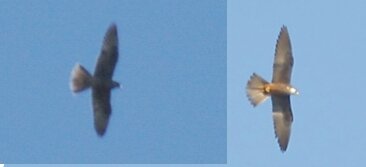
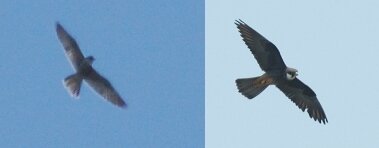
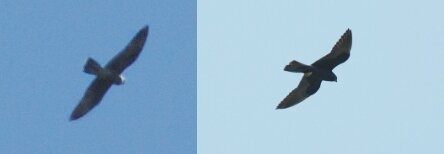
I also consulted raptor expert Dick Forsman (www.dickforsman.com) and this was his response:
I can only agree with you, that the bird in the image is a young dark morph Eleonora’s Falcon. The falcon is young because of its prominent white tail-tip and trailing edge to the wing. Identifying it as an Eleonora’s is to push it a bit, as some juv Hobbies can look extremely similar when viewed against the light and in slightly blurred images like this. However, in this case I believe, that what we see is also the actual truth.
So, all in all it was an action-packed morning that produced no less than 8 raptor species. Raptor watching can be a pot-luck affair, but I’ll certainly be putting in some more time this weekend so feel free to join me if you’re keen to catch up with some of the Peninsula’s raptors.
David Winter
Kirstenbosch bird list: Sombre Greenbul, Cape Sugarbird, Swee Waxbill, Cape Canary, Orange-breasted Sunbird, Cape White-eye, Forest Canary, Steppe Buzzard, Forest Buzzard, Honey Buzzard, Booted Eagle, Rock Kestrel, African Harrier Hawk, African Fish-Eagle, Southern Boubou, Paradise Flycatcher, Cape Batis, Black Saw-wing, Bar-throated Apalis, Cape Robin-Chat, Red-winged Starling.
January 17th, 2011
While raptor watching at Kirstenbosch Botanical Gardens on Saturday I snapped these poor images of a large falcon. It unfortunately did not hang around and was last seen heading south in the direction of Cecilia Forest. My suspicions, and the opinions of a couple of raptor experts, point towards Eleonora’s Falcon. Does anyone else perhaps have an opinion regarding its identification?



David Winter
January 11th, 2011

Cape Leopard Trust Camera Trap
This is the closest I’ve come to seeing a Leopard in the Cape… While riding in the Palmiet river valley on Sunday I came across this camera trap, a vital piece of equipment for the Cape Leopard Trust’s research on this very elusive predator. Cape Leopard (the smaller cousin of the larger bushveld variety), is extremely shy and practically impossible to see, hence the use of camera traps. Here’s an excerpt from the Cape Leopard Trust’s website on camera trapping:
How do you find such a secretive animal in such a vast and untamed area? The short and general answer is: You don’t! Cape Leopards are notoriously shy and elusive; extremely few people have been lucky enough to see one – and when they do it is usually only a short glimpse. Fortunately, there is a solution – digital cameras, containing an infrared sensor triggered by motion and heat (referred to as a “camera trap”). Camera-trapping has proved to be a very effective way of estimating the numbers of elusive and nocturnal animals such as large carnivores (e.g. tigers in India). It is a non-invasive and comparatively affordable option, since it does not require the capture, handling, or immobilisation of animals. Photographs of leopards are an exceptionally useful tool, since each leopard has a distinctive spot pattern – almost like our fingerprints – by which it can be identified. Camera traps can be deployed singly, but ideally a camera station should consist of two cameras opposite each other. Such double stations are used to compile “leopard identikits” – photos of both an individual’s left and right flanks – which are crucial in estimating the number of individuals in an area. [more here]
The thought that leopards roam the Kogelberg certainly gives the area a distinct charm. Apart from the infamous “Betty’s Bay Leopard” of the 1980′s, which was well known for being decidedly un-elusive and its penchant for African Penguins, the only recent local reports I’m aware of are unconfirmed sightings from Hangklip. Does anyone else perhaps know of other sightings from the area?
Do visit the Cape Leopard Trust website, it’s a fascinating project.
David Winter
January 7th, 2011

Sentinel Rock-Thrush
Patrick Cardwell took this excellent shot of a male Sentinel Rock-Thrush at Sir Lowry’s Pass, Cape Town earlier last year. Sentinel’s can be difficult to find in the Cape, but Sir Lowry’s Pass, Rooi Els, Cape Point and even Table Mountain have been turning up the goods of late.
January 6th, 2011

Betty Pauciello fled the corporate world nearly 18 years ago, shedding a job as director of operations at a computer company that had become more about preparing layoff lists than anything else. Actually, took flight might be a better way to describe Pauciello’s departure, considering what lured her away: Birds. A longtime enthusiast of the feathered sort, the Bucks County resident decided to turn a backyard hobby into a career and, consequently, base her income on the eating habits of those weighing barely an ounce, if that. [Philadelphia Inquirer]
December 19th, 2010
As I sat in my offices over the last two weeks with news of the Pipit in Pongola it was tough to concentrate on work. I had given up a chance at twitching the bird last weekend as I just felt it was not justifiable. You see, I have never really travelled huge distances to see one particular bird and I don’t consider my SA list to be large enough to justify a “drop everything at once” type of twitch. However, it became increasingly obvious to me at the beginning of the week that I may not be able to let this one go. The discovery of the Buff-breasted Sandpiper was also a factor and before I knew it I was scheming about getting a crazy trip past the family.
Now, to take a step backwards in time I need to set the scene. My father and I started our birding careers at the same time, about 31 years ago, when I was 6 years old. Over the intervening years I have slowly advanced my list at a slightly faster rate than my father owing mainly due to his inability to get away as often as I was able to, plus the fact that maybe I was just a little more fanatical than he was. We have, over the years, shared many birding trips together, though with some memorable experiences. My father is now in his 70’s and despite his continual insistence that he is old and crotchety I still see the potential for many more trips together. My father quickly became my first target companion for this trip.
As for step 2 in the process of justifying this crazy jaunt I had to satisfy my wife that the time away from the family was entirely justified. We were due to commence with our annual December festive season holiday in St Francis and it seemed a “no hoper” to escape for 2 days for the Pipit.
My wife and I are lucky to have 3 sons (ages of 7, 5 and 3) and since they have been young (yes, I know they still are pretty young but it is all relative) I have been very careful to avoid the over-fanatical fatherly desire to make them birding companions from an early age. I always recall a friend of mine telling me that she was dragged off on birding trips with her parents from a very young age and quite frankly, another car stop at a Rattling Cisticola in Kruger may just drive her over the edge. The last thing I wanted to do was to force the birding on my kids and turn them all against something that has become so much a part of my life. So, I left them at home when I went on my birding forays and they got used to my 5am wake up time on holidays while I went out birding. I thought I’d leave it for the day that they were asking to come with me rather than the other way around.
I decided a few months ago that my oldest boy, Tommy, was worth giving a bash at fostering an early interest. After all, I was 6 when I became hooked so he should be old enough. I also realized that one of the key factors was that he was nearing the end of Grade one and he had been taught how to read. It seems more important than you would believe that kids are able to associate a name to a bird and be able to read this on a list or in a field guide in order for them to really bridge the gap between pointing out the occasional Hadeda Ibis and truly enjoying the pastime of true birding. Adam, my middle son, is also showing a desire to join us but he just cannot read the names yet and it makes it difficult for him.
So, Tommy and I set about discovering how we coped with birding together. A few local twitches (Green-backed Heron and Squacco Heron in the Western Cape) and a few weekends away in Tulbagh, Oudtshoorn and Kleinmond showed me that he actually enjoyed being out there with me. He also started his life list and it wasn’t long before he started to get that excitement every time I pointed out a new bird for him. Admittedly, there does seem to be an over reliance on the list rather than just being out there to see the birds but if that is what it takes to have the little man by my side then so be it.


I went out and bought the Roberts Multimedia and we embarked on a life list for Tommy. It was just so amazing to be back at the beginning again and to be experiencing all these birds with him as though it were my first time. A silly little Common Chaffinch in Kirstenbosch was a new bird for his list (it was probably close to his 100th bird) but yet it brought a smile to his face that is hard to describe. We got home and it went straight into the list module of Roberts Multimedia.

He sits on my lap as we do the list and as I call out the birds he shouts out “yes, I remember that one. It was the one with the reddish tummy and the green back and it was hopping on the ground”. As an aside, it will be a sad day when he stops using the word “tummy” and “top part” and resorts to the more conventional “underparts “ and “upperparts” to describe those critical anatomical features of a bird. He has also come up with some ways to classify the birds. Never mind the passerines and non-passerines and the wealth of genera; Tommy has adopted a few major groups including the “hairstyle” birds which account for any bird that seems to have even slightly ornate feathering on its head (who says you can’t put Long-crested Eagle, Speckled Mousebird and Knysna Turaco in the same group) whilst the “criminal birds” seem to have some sort of mask or cap on their heads (once again let’s lump a Red-billed Teal together with Kittlitz’s Plover, Cape Robin-chat and Olive Bush-shrike in the same category). It would be madness to correct him and change those quirks that make the birding trips with Tommy as refreshing as they are.
So, we got through a few 2 or 3 hour birding trips with very little pain and still the craving was there. I sighed a few sighs of relief when we were hardly back at home before he was asking about the next trip. Last weekend was the big test. Partly to compensate for my lack of trying for the pipit but mainly to see how Tommy enjoyed a slightly longer outing I took him out to West Coast National Park with me for an entire morning. We birded solidly for 8 hours stopping at all my old favourite places in the park including the long walk to the salt marsh hides and the schlep down to the Seeberg hide. He was an absolute star and it was only when we settled into the seats at Geelbek for some wader watching that he seemed to think we had been out there long enough. Well seasoned wader buffs are happy to scan the mudflats looking for that one grey-brown thingy with a long beak which it probes into the sand which is fractionally different to the 5000 others, but when it is the tail-end of your first extended day of birding it is likely to be too much for anyone, never mind for a 7 year old. It was no sooner that we were back in the car, though, that Tommy was pointing out every single YBK (Yellow-billed Kite) on the dreary drag back to Cape Town.
With the West Coast trip behind us and no sign of him slowing down his march to become the number one birder in the country (watch your backs, Ian and Trevor and co) I felt that there may be something special in the offing. His list had reached the heady heights of 165 and we needed to break some frontiers. Or at least that would be what I would tell his mother.
On Monday morning I called my faithful birding companion (my father) and asked him what he thought of a two day blitz in Zululand and Pongola to pursue the pipit and seek the sandpiper. To add to the appeal I suggested we take Tommy with us. His oldest grandson as a companion – how could he say no?
So, after some negotiating with the wife (she happily admitted to me that she hoped that stupid pipit took flight and returned to where it came from before the week was out so that we would have to cancel – thank goodness that never happened proving at least that she has no mystical powers despite what I may have thought for all these years while I was on the golf course and the rain came pouring down!) I managed to get the “pink” (or would that be “golden”) ticket that I so desperately needed.
The plans started taking shape. We would leave Cape Town with the whole family and drive seven and a half hours to St Francis Bay. Spend the night there and the next morning drive to Port Elizabeth with my father and Tommy, board a flight to Durban and then haul up the N2 to Pongola Nature Reserve. The GPS points were keyed in and we left on our journey. We had up to the minute reports of the bird still putting on a show and despite the buckets of rain that had fallen in the past few days in that area it seemed as if the “Pongola Pipit” had decided that it was a good place to stay for a while.
Our drive along the N2 was pretty uneventful except for a tragic incident during which I pointed out a Long-crested Eagle (hairstyle bird) perched on a telephone pole somewhere near Hluhluwe and by some quirk of unfortunate fate Tommy seemed to miss it. It became the “dip of the trip” to that point and I was not sure a golden beauty would even be enough to recover.

It is worth mentioning that Tommy has installed himself as a raptor spotter extraordinaire. He sees soaring raptors from kilometers away and makes no bones about announcing it at the top of his voice. There were a few YBK’s that almost had my father driving the rental car off the N2 into a roadside ditch. The missed Long-crested Eagle was compensated for by a spectacular view of a low soaring Palm-nut Vulture about 5 kms north of Mtunzini but despite this pretty spectacular bird that I managed to point out to Tommy, it seemed as if it was somehow my fault that his list had a gap in the tick box opposite the Long-crested Eagle. I told him with confidence (my voice belied the way I felt inside) that we would definitely see one on the way back to the airport less than 24 hours later.
A few phone calls to Trevor had me feeling quite confident about the pipit, but would the three of us be the first group to not see the pipit? My heart starting beating faster as we got closer to Pongola Nature Reserve and I could feel that Tommy was also starting to get excited. We signed in at the gate and drove the 1.5kms or so to the spot and since there was no one there at the time we had to find the bird ourselves. It certainly didn’t take too long. There it was perched on the mid size bush as if it was waiting for us to arrive.
I was stunned and I suspect my father and Tommy were as well. In a few brief moments I felt that it had been worth this journey but somehow I think I knew that before we even saw the bird. Being a twitch spanning three generations, it was already special before even being successful.
We all jumped out of the car and my camera started working overtime. I took hundreds of photos, mostly pretty poor but managed one or two half reasonable ones. It was during one of my photographic bursts with the bird quite close by that I think I noticed how hot it was (the weather, not the bird). It was exactly mid-day and it was searingly hot. My watch (probably not the most reliable meteorological device) told me that it was 39 degrees but it was the humidity that was the real kicker. In the moment of being caught up with such a great bird I think I momentarily forgot about how Tommy was doing. Then suddenly I realized he wasn’t by my side savouring the sighting. Where was he? I quickly discovered that he was curled up in the car much like an overheated dog would be, panting at pace, trying to cool down. Here was this fragile seven year old who had grown up in the mildest of climates in Cape Town being exposed to 39 degree heat with extreme humidity. The poor child was literally melting. He looked at me with his large blue eyes and only just managed to tell me that he thought we should probably go now. We had come such a long way but we had seen what we wanted to and after taking a few more pics it was probably not the worst idea to close the windows and turn on the aircon at full blast. After all, we had more work to do that afternoon with the Buff-breasted Sandpiper less than 100kms away at Muzi pan.



We wrapped up at the pipit and after collecting a few quarts of beer and a huge bag of ice at the border-side bottle store we headed south again en route to Mkuze Game Reserve and Muzi Pan for the Buff-breasted Sandpiper. The post lunch session gave Tommy a chance to recharge his batteries as he crashed on the back seat while we jilted and jolted along the rather dreadful road that leads one to Mkuze. An opportune wee stop (this was certainly not the first of the trip) saw us tick White-throated Robin-chat and Long-tailed Paradise Whydah and then it was straight to Muzi pan. The road to the pan is equally dodgy with an interesting mix of urban taxis, goats, cows and crowds of people whiling away the day. We got to the paradise that is Muzi pan and soon after we were happily ticking the Buff-breasted Sandpiper. An obliging Pectoral Sandpiper also made an appearance but after the Golden Pipit it all seemed a little anticlimactic.


I was elated but once again we were in that realm of anorak clad birders shielding against the elements (let it be said we were at Muzi pan on a spectacular sunny and windless afternoon) and sifting through hundreds of birds that all essentially look the same. Tommy has not yet coined a phrase for this rather inelegant bunch but it is a matter of time before they become the “boring birds”. I suspect in years to come he may tune his excellent eyes to the waders in the same fanatical way that I do but at the moment I can forgive him for being more interested in the larger more colourful specimens. Fortunately Muzi pan is a fledgling birder’s paradise as well, as there is a plethora of colourful species to add to the ever growing list. Yellow-billed Storks, Great Egrets, Whiskered Terns, African Jacanas, Collared Pratincoles, Malachite Kingfishers, Brown-throated Weavers and Pink-backed Pelicans were just a few of the birds that made up the numbers. I was in birding heaven not having seen such a wealth of species in such a long time but the sun was starting to dip beyond the horizon and we had to make our way to the main camp in Mkuze for a night in the bush.


I have seldom spent much time in Malaria infested areas but Mkuzi in mid-summer kind of gave me the heebie-jeebies. Plenty of rain had fallen and the wet, humid conditions seemed to be ideal for the cultivation of lots of anopheles mosquitoes and not only was I making sure that I survived the experience but I had dragged my 7 year old along with me and his mother had given me a lecture of epic proportion noting how careful we needed to be. Tommy and I sat in our bungalow with windows closed, tabard spray everywhere, hauling on as many body-covering items of clothing as we could find in 30 degree heat. The crowning moment was the spreading of the mosquito net which turned into a debacle as the spinning fan caught the supporting cable of the net and wrapped the whole contraption in the blades of the fan. The fan ground to a halt and now the net was suspended amongst the blades about 8 foot from the ground with not much hope of redemption. A moment of sheer genius from Grandpa Brian saw us spinning the blades in the opposite direction and in so doing loosening the vice like grip it had on the mosquito net.
We survived the night relatively unscathed (it is still too early to tell whether we managed to escape the dreaded disease but I am yet to find a bite on mine or Tommy’s body so I think we may be okay). The next day was an overwhelming experience for all of us with Mkuze in fine form presenting us with all the birds we have not seen for so many years. We caught up with what I consider to be the big three of the Sand Forest (Pink-throated Twinspot, Rudd’s Apalis and Neergaard’s Sunbird) as well as ticking a huge number of species for Tommy’s list. It was all too soon before we had to take our leave from birding paradise and begin the journey to King Shaka International to catch our flight back to Port Elizabeth.



A few memorable moments (some good and some bad) marked the journey back home. The first objective was to find that elusive Long-crested Eagle which we did quite satisfactorily. As soon as I saw it perched on a telephone pole 300 metres away I ranted as loudly as I could to make sure Tommy did not miss it. That monkey was now off my back and I could relax knowing that I had not caused the failure of the trip in Tommy’s young, impressionable eyes.
The next memorable moment was a sign of the true birding bug having bitten my eldest son. He lay down on the back seat to once again recharge his young batteries and after a few minutes I noted large pineapple plantations on either side of the car. Not wanting to be totally exclusionary of all other things besides birds I decided to point out the pineapples: “Tommy, quick, look. Can you see the pineapples?” He shot up from his horizontal position, looked out the window in a panic and shouted “Where, where? Where is the Pied Apalis?” And, as much as you may think this story is conjured up using a lot of poetic license I can honestly say that it is entirely true.
The final memorable moment is one that I would almost like to forget. We arrived at the airport in plenty of time (and just remember that missing this flight would probably put to an end any birding trip that I may want to take in the future) but a delayed check-in and very slow service at the airport restaurant had us putting our bags through the security check point as they announced the closure of our flight for boarding. In our panic my father left his cell phone in the security tray which I fortunately saw and picked up but we all started a frantic sprint to the boarding gates. We reached the gates just in time only for us to get on the bus and for me to realise that in the rush of picking up my father’s cell phone I had left my camera bag with all my priceless photos of the Golden Pipit at the security checkpoint. I didn’t even wait for the boarding assistant to stop me – I did the Shaka International 200 metre dash in record time to thankfully find my bag still sitting at the end of the x-ray machine. Even though I am now in my late thirties I am apparently still not old enough to avoid a lecture from my father about making sure I look after my things. It was a good example for Tommy to see this but I had to point out that the only reason I left my bag behind was because I was so busy salvaging my father’s cell phone…
So, despite that rather frantic end to our trip the short flight home gave Tommy and I an opportunity to update his list (which he now carries with him everywhere) and to discover that we have already reached 235 species. It was a truly memorable trip shared between a grandfather, a father and a son and I know it is something that I will never forget and I suspect neither will my father or Thomas.
Mike Buckham
November 7th, 2010
Guilty of perhaps not doing as much babysitting as any self-respecting uncle should, I took my budding-birder niece, Rose Mitchell (age 9) off to Paarl Bird Sanctuary recently. To lower the average age even more, Mike Buckham took his equally keen son Thomas and one of his friends.

The real reason Mike and I were at Paarl was to look for the Green-backed Heron, but it was nice to show the kids some new birds. The heron was rather uncooperative, but it did put in a very brief fly-by. I hadn’t been to Paarl for a few years and was reminded as to what a great reserve it is, particularly for birders who carry a camera.

The Common Sandpipers that frequent the edge of the pans and water channels are usually nice and obliging.

Not always an easy species to pin down, we were pleasantly surprised to see this African Black Duck in the channel close to the heronry. The nearby Berg River is usually the preferred habitat for this species.

White-faced Duck is becoming more regular in the Western Cape.

This male Maccoa Duck gave us a great quivering-tail display.

One last Common Sandpiper photo.

Directions to Paarl Bird Sanctuary.
Paarl Bird Sanctuary bird list: Common Starling, Barn Swallow, African Reed-Warbler, Sacred Ibis, African Darter, Grey-headed Gull, Reed Cormorant, Malachite Kingfisher, Red-knobbed Coot, Common Moorhen, Green-backed Heron, Little Rush-Warbler, Fiscal Flycatcher, Cape White-eye, Grey-headed Sparrow, African Harrier Hawk, Jackal Buzzard, White-throated Swallow, Hartlaub’s Gull, Cattle Egret, Cape Wagtail, Little Grebe, Greater Flamingo, White-faced Duck, Maccoa Duck, Cape Teal, Red-billed Teal, Southern Pochard, Black-necked Grebe, Great-crested Grebe, House Sparrow, Paradise Flycatcher, African Dusky Flycatcher, Swee Waxbill, Olive Thrush, Cape Canary, Lesser Swamp-Warbler, Grey Heron, Black-headed Heron, African Purple Swamphen, Black-winged Stilt, Pied Avocet, Black-crowned Night-Heron, Hadeda Ibis, Pied Crow, Levaillant’s Cisticola, Bar-throated Apalis, Cape Robin-chat, Red-winged Starling, Southern Double-collared Sunbird, Southern Masked-Weaver
David Winter
September 24th, 2010

Dead whale, Gordon’s Bay
Driving from Gordon’s Bay to Rooi Els on Friday I noticed a tight flock of birds low over the water in the bay, unlike a typical feeding flock. On closer inspection I was surprised to see a mixed group of birds feeding on a dead whale! It was difficult to determine the species, but judging by the size I would guess it was either a Southern Right or Humpback. In attendance were Kelp Gulls, Subantarctic Skua and a handful of Giant Petrels, which I thought was interesting.
I was hoping to catch a glimpse of a Great White Shark taking a nibble, but no luck! A dead Bryde’s Whale was towed to Seal Island, False Bay earlier this week and at least 30 Great White Sharks pitched up for the meal [read more here].
David Winter
|
|




















































Comments